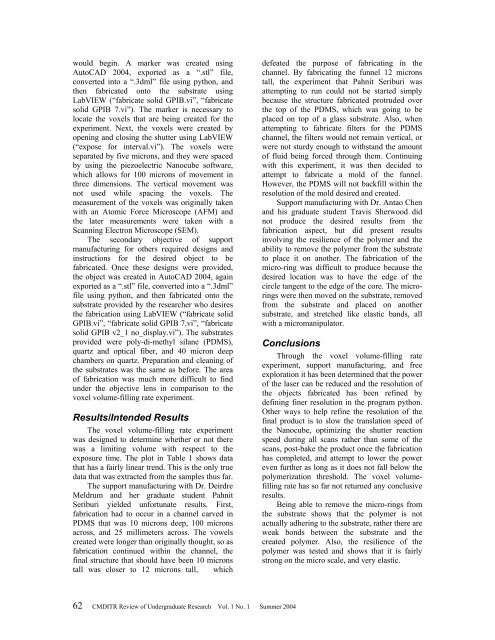CMDITR Review of Undergraduate Research - Pluto - University of ...
CMDITR Review of Undergraduate Research - Pluto - University of ...
CMDITR Review of Undergraduate Research - Pluto - University of ...
Create successful ePaper yourself
Turn your PDF publications into a flip-book with our unique Google optimized e-Paper software.
would begin. A marker was created using<br />
AutoCAD 2004, exported as a “.stl” file,<br />
converted into a “.3dml” file using python, and<br />
then fabricated onto the substrate using<br />
LabVIEW (“fabricate solid GPIB.vi”, “fabricate<br />
solid GPIB 7.vi”). The marker is necessary to<br />
locate the voxels that are being created for the<br />
experiment. Next, the voxels were created by<br />
opening and closing the shutter using LabVIEW<br />
(“expose for interval.vi”). The voxels were<br />
separated by five microns, and they were spaced<br />
by using the piezoelectric Nanocube s<strong>of</strong>tware,<br />
which allows for 100 microns <strong>of</strong> movement in<br />
three dimensions. The vertical movement was<br />
not used while spacing the voxels. The<br />
measurement <strong>of</strong> the voxels was originally taken<br />
with an Atomic Force Microscope (AFM) and<br />
the later measurements were taken with a<br />
Scanning Electron Microscope (SEM).<br />
The secondary objective <strong>of</strong> support<br />
manufacturing for others required designs and<br />
instructions for the desired object to be<br />
fabricated. Once these designs were provided,<br />
the object was created in AutoCAD 2004, again<br />
exported as a “.stl” file, converted into a “.3dml”<br />
file using python, and then fabricated onto the<br />
substrate provided by the researcher who desires<br />
the fabrication using LabVIEW (“fabricate solid<br />
GPIB.vi”, “fabricate solid GPIB 7.vi”, “fabricate<br />
solid GPIB v2_1 no_display.vi”). The substrates<br />
provided were poly-di-methyl silane (PDMS),<br />
quartz and optical fiber, and 40 micron deep<br />
chambers on quartz. Preparation and cleaning <strong>of</strong><br />
the substrates was the same as before. The area<br />
<strong>of</strong> fabrication was much more difficult to find<br />
under the objective lens in comparison to the<br />
voxel volume-filling rate experiment.<br />
Results/Intended Results<br />
The voxel volume-filling rate experiment<br />
was designed to determine whether or not there<br />
was a limiting volume with respect to the<br />
exposure time. The plot in Table 1 shows data<br />
that has a fairly linear trend. This is the only true<br />
data that was extracted from the samples thus far.<br />
The support manufacturing with Dr. Deirdre<br />
Meldrum and her graduate student Pahnit<br />
Seriburi yielded unfortunate results. First,<br />
fabrication had to occur in a channel carved in<br />
PDMS that was 10 microns deep, 100 microns<br />
across, and 25 millimeters across. The vowels<br />
created were longer than originally thought, so as<br />
fabrication continued within the channel, the<br />
final structure that should have been 10 microns<br />
tall was closer to 12 microns tall, which<br />
defeated the purpose <strong>of</strong> fabricating in the<br />
channel. By fabricating the funnel 12 microns<br />
tall, the experiment that Pahnit Seriburi was<br />
attempting to run could not be started simply<br />
because the structure fabricated protruded over<br />
the top <strong>of</strong> the PDMS, which was going to be<br />
placed on top <strong>of</strong> a glass substrate. Also, when<br />
attempting to fabricate filters for the PDMS<br />
channel, the filters would not remain vertical, or<br />
were not sturdy enough to withstand the amount<br />
<strong>of</strong> fluid being forced through them. Continuing<br />
with this experiment, it was then decided to<br />
attempt to fabricate a mold <strong>of</strong> the funnel.<br />
However, the PDMS will not backfill within the<br />
resolution <strong>of</strong> the mold desired and created.<br />
Support manufacturing with Dr. Antao Chen<br />
and his graduate student Travis Sherwood did<br />
not produce the desired results from the<br />
fabrication aspect, but did present results<br />
involving the resilience <strong>of</strong> the polymer and the<br />
ability to remove the polymer from the substrate<br />
to place it on another. The fabrication <strong>of</strong> the<br />
micro-ring was difficult to produce because the<br />
desired location was to have the edge <strong>of</strong> the<br />
circle tangent to the edge <strong>of</strong> the core. The microrings<br />
were then moved on the substrate, removed<br />
from the substrate and placed on another<br />
substrate, and stretched like elastic bands, all<br />
with a micromanipulator.<br />
Conclusions<br />
Through the voxel volume-filling rate<br />
experiment, support manufacturing, and free<br />
exploration it has been determined that the power<br />
<strong>of</strong> the laser can be reduced and the resolution <strong>of</strong><br />
the objects fabricated has been refined by<br />
defining finer resolution in the program python.<br />
Other ways to help refine the resolution <strong>of</strong> the<br />
final product is to slow the translation speed <strong>of</strong><br />
the Nanocube, optimizing the shutter reaction<br />
speed during all scans rather than some <strong>of</strong> the<br />
scans, post-bake the product once the fabrication<br />
has completed, and attempt to lower the power<br />
even further as long as it does not fall below the<br />
polymerization threshold. The voxel volumefilling<br />
rate has so far not returned any conclusive<br />
results.<br />
Being able to remove the micro-rings from<br />
the substrate shows that the polymer is not<br />
actually adhering to the substrate, rather there are<br />
weak bonds between the substrate and the<br />
created polymer. Also, the resilience <strong>of</strong> the<br />
polymer was tested and shows that it is fairly<br />
strong on the micro scale, and very elastic.<br />
62 <strong>CMDITR</strong> <strong>Review</strong> <strong>of</strong> <strong>Undergraduate</strong> <strong>Research</strong> Vol. 1 No. 1 Summer 2004




